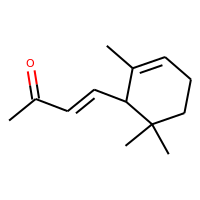
alpha-Ionone
| Chemical identification | |
|---|---|
| Pubchem identifier | 5282108 |
| CAS identifier | 127-41-3 |
| DSSTOX identifier | DTXSID0035160 |
| IUPAC name | alpha-Ionone |
| SMILES | CC1=CCCC(C1C=CC(=O)C)(C)C |
| InChI | InChI=1S/C13H20O/c1-10-6-5-9-13(3,4)12(10)8-7-11(2)14/h6-8,12H,5,9H2,1-4H3/b8-7+ |
| InChIKey | UZFLPKAIBPNNCA-BQYQJAHWSA-N |
| Synonyms | Cyclocitrylideneacetone, alpha-; alpha-Ionone; (+-)-trans-alpha-Ionone; (E)-(1)-4-(2,6,6-Trimethyl-2-cyclohexen-1-yl)-3-buten-2-one; 3-Buten-2-one, 4-(2,6,6-trimethyl-2-cyclohexen-1-yl)-, (3E)-; Ionone, alpha-; 4-(2,6,6-Trimethyl-2-cyclohexen-1-yl)-3-buten-2-one; (E)-alpha-Ionone; 3-Buten-2-one, 4-(2,6,6-trimethyl-2-cyclohexen-1-yl)-, (E)- |
| Odor profile | |
|---|---|
| Odor classes | Aromatic, Edible oil, Floral, Herbs, Seed spices, Vegetable |
| Reference | [1] |
| Presence in Children's products | |
|---|---|
| Broad category | Skin care |
| Subcategory | Bath And Lotion |
| Chemical classification based on ClassyFire | |
|---|---|
| Chemical kingdom | Organic compounds |
| Chemical super-class | Lipids and lipid-like molecules |
| Chemical class | Prenol lipids |
| Chemical subclass | Sesquiterpenoids |
| Natural source for the chemical | |||
|---|---|---|---|
| Organism | Kingdom | Genus | Family |
| Citrus reticulata | Plantae | Citrus | Rutaceae |
| Acacia farnesiana | Plantae | Acacia | Fabaceae |
| Crateva nurvala | Plantae | Crateva | Capparaceae |
| Viola odorata L. | Plantae | Viola L. | Violaceae |
| Inula racemosa | Plantae | Inula | Asteraceae |
| Lawsonia inermis | Plantae | Lawsonia | Lythraceae |
| Azadirachta indica | Plantae | Azadirachta | Meliaceae |
| Carica papaya | Plantae | Carica | Caricaceae |
| Reference | [1], [2], [3], [4], [5] | ||